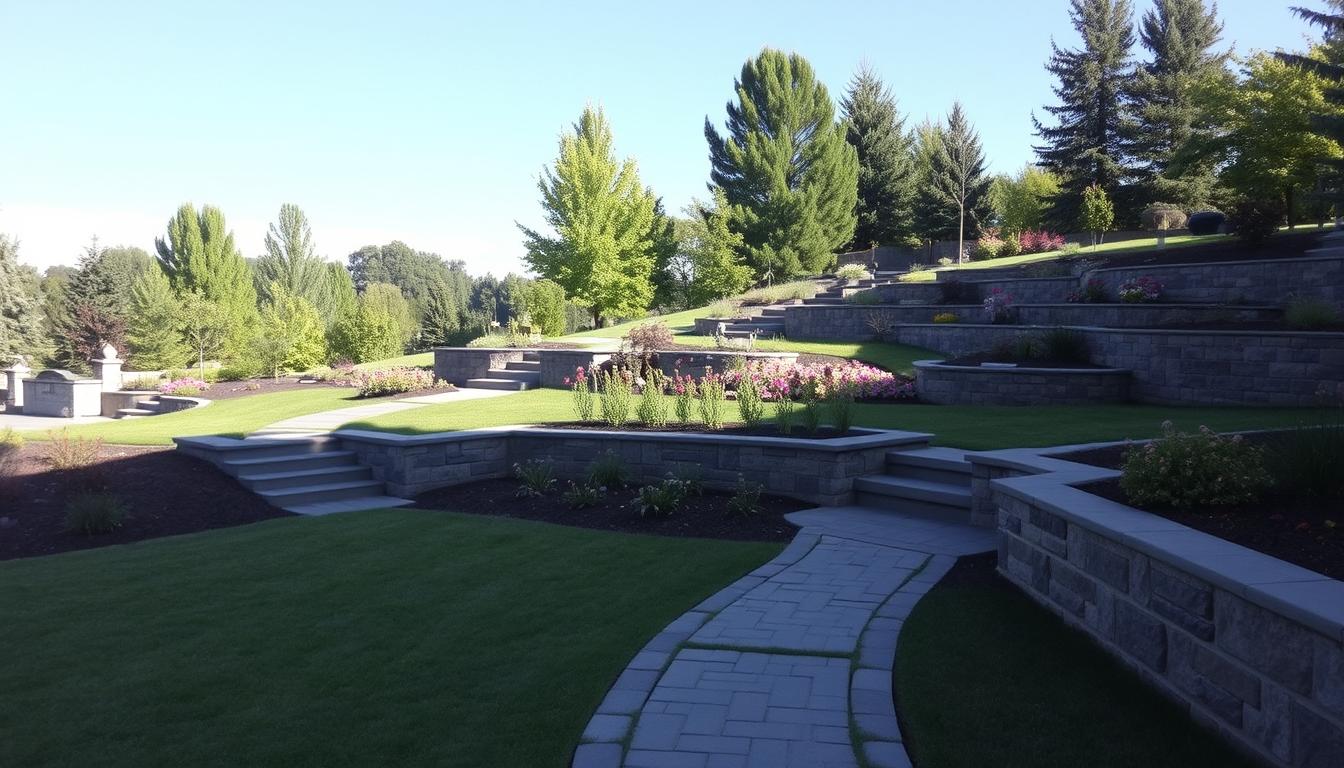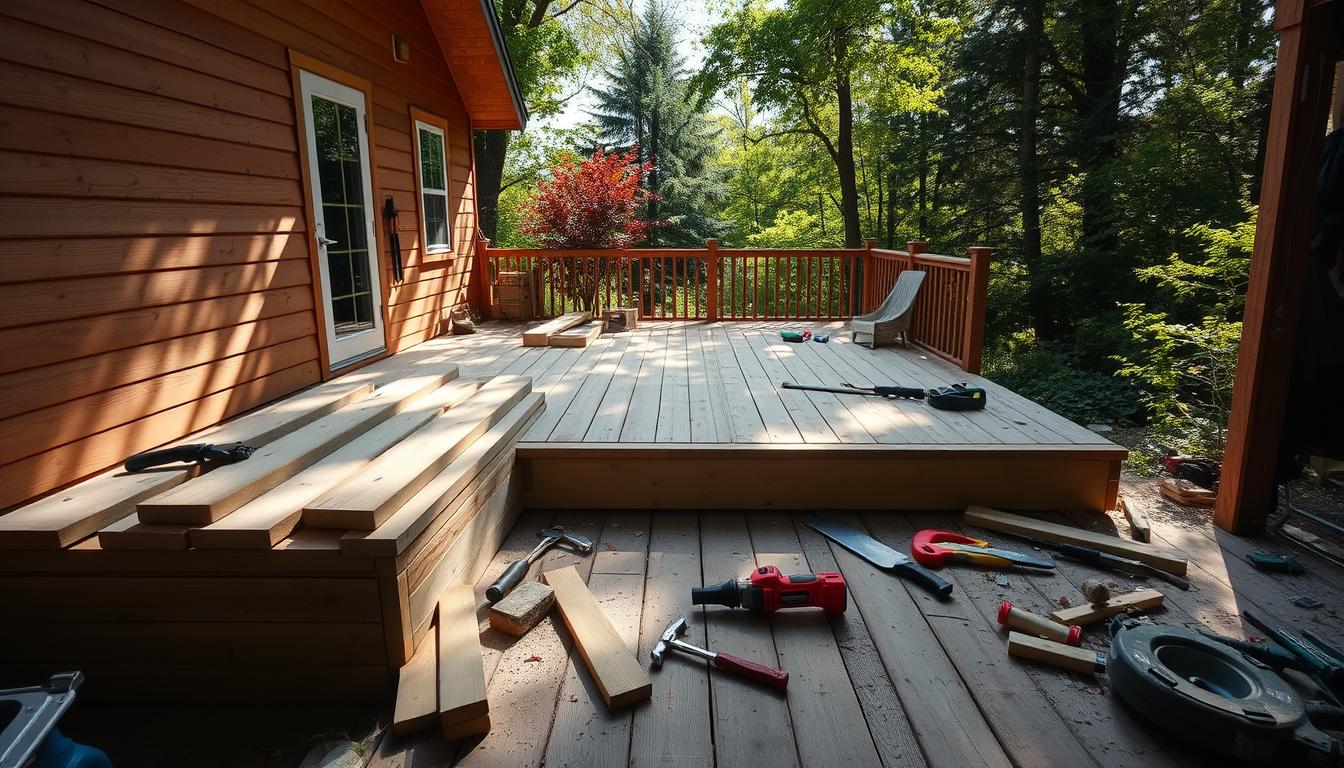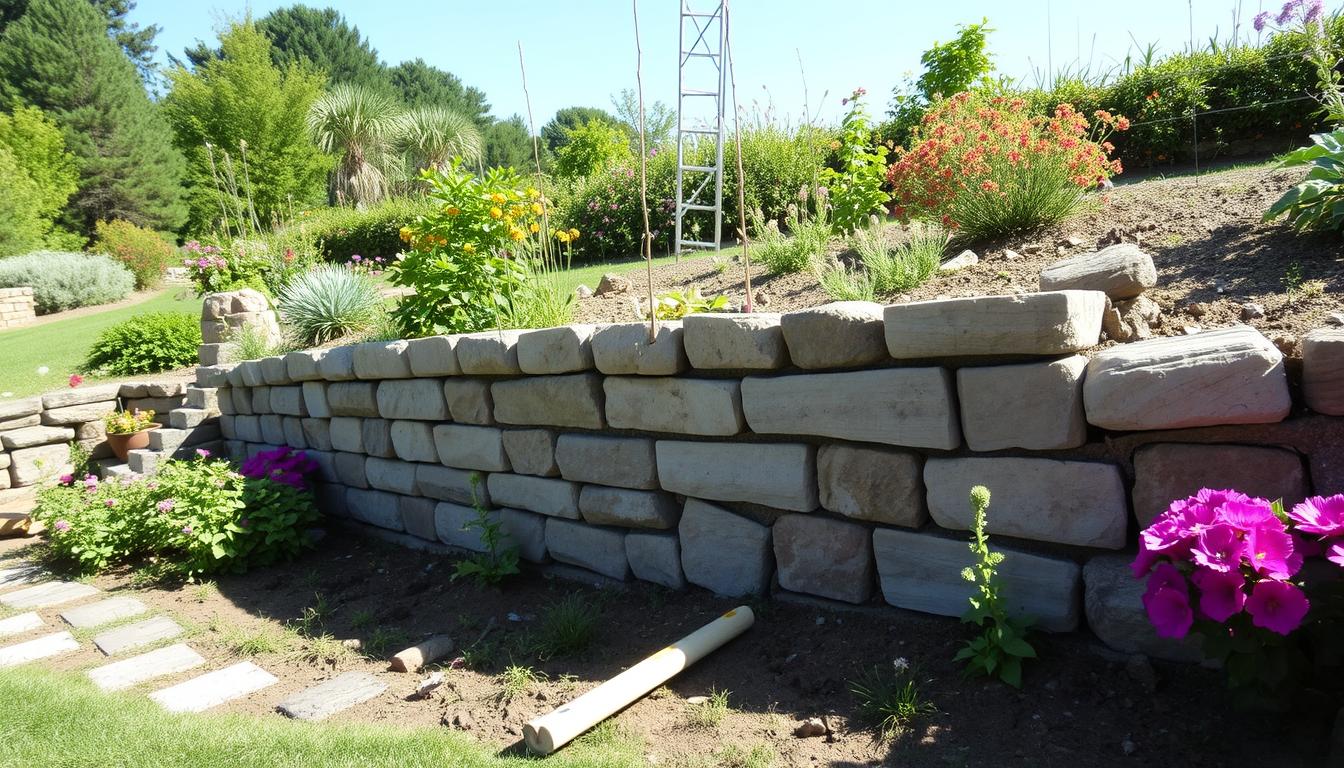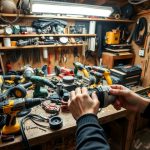In landscape design, a beautiful and functional outdoor space is key. Hardscaping focuses on non-living elements like patios, walkways, and retaining walls. These features boost property value, enhance functionality, and improve aesthetic appeal of outdoor surfaces.
Hardscaping is crucial in landscape design, offering durable and low-maintenance outdoor solutions. The right materials and design elements can create stunning, functional areas that match your home and lifestyle. Whether it’s a relaxing patio or a practical walkway, hardscaping can meet your needs and beautify your outdoor spaces.
Introduction to Hardscaping
Hardscaping uses materials like stone, concrete, and wood for permanent landscape structures. Features such as outdoor kitchens, fire pits, and water features add value and beauty. Understanding hardscaping basics allows you to design a unique, functional outdoor space that reflects your style and complements your landscape.
Key Takeaways
- Hardscaping is a crucial aspect of landscape design, focusing on non-living elements like patios and walkways.
- Hardscaping can increase property value, improve functionality, and enhance aesthetic appeal.
- Outdoor surfaces, such as patios and walkways, can be designed to be durable and low-maintenance.
- Hardscaping involves the use of various materials, including stone, concrete, and wood.
- Permanent landscape structures, like outdoor kitchens and fire pits, can add value and beauty to your property.
- Hardscaping can help create a unique and functional outdoor space that complements your landscape design.
Understanding Hardscaping Fundamentals
In the realm of outdoor spaces, material selection is paramount. Hardscaping employs hard materials like stone, concrete, and wood for lasting landscape features. These can be patios, walkways, or retaining walls, boosting both function and beauty of outdoor areas.
Effective yard planning is vital for blending hardscape elements into the landscape design. It involves assessing drainage, soil, and climate to pick the right materials and design for the project.
Hardscaping offers several advantages, including enhanced durability and lower maintenance needs. These elements can endure harsh weather and need less care than softscape elements like plants. They also help prevent erosion and improve drainage, reducing water damage risks.
Defining Hardscape Elements
Hardscape elements are non-living parts of a landscape design. They include:
- Patios and walkways
- Retaining walls and steps
- Outdoor kitchens and fire pits
Soft vs Hard Landscaping Features
Soft landscaping, like plants and grass, brings color and texture to outdoor spaces. Yet, they need regular care and can be vulnerable to weather damage. Hard landscaping, by contrast, is more durable and needs less maintenance.
Benefits of Permanent Landscape Structures
Permanent landscape structures, like hardscape elements, offer several benefits:
| Benefit | Description |
|---|---|
| Increased durability | Hardscape elements can withstand harsh weather conditions and require less upkeep. |
| Improved drainage | Hardscaping can help to prevent erosion and improve drainage, reducing the risk of water damage. |
| Enhanced aesthetic appeal | Hardscape elements can add texture and interest to outdoor spaces, enhancing their overall aesthetic appeal. |
Essential Planning Steps for Your Hardscape Project
In the realm of outdoor construction, planning is paramount for a space that’s both functional and visually stunning. Before starting, it’s vital to evaluate the site, set a budget, and pick your materials. This initial phase is critical to guarantee the final outcome aligns with your vision and requirements.
A meticulously planned hardscape project must consider drainage, lighting, and irrigation. These factors are crucial to avoid future problems, saving you both time and money. The design should also include the strategic placement of features like patios, walkways, and retaining walls.
Key aspects to ponder for your outdoor construction project include:
- Site analysis: assessing terrain, soil, and climate for optimal planning
- Budgeting: setting a realistic budget and adhering to it
- Material selection: opting for materials that are durable, easy to maintain, and aesthetically pleasing
By investing time in detailed planning for your hardscape project, you’ll craft an outdoor area that’s both attractive and practical. It’s wise to consider hiring a professional contractor or landscaper to ensure the project is executed properly and safely.
Material Selection Guide for Outdoor Surfaces
Choosing the right materials for outdoor spaces is key to durability and beauty. The correct materials can elevate both the look and function of your outdoor areas. They must also withstand the elements and heavy use. This guide will cover various options, including natural stone, concrete, pavers, wood, composite materials, and metal elements.
Success in material selection hinges on considering climate, traffic, and maintenance needs. For instance, natural stone is prized for its durability and beauty but demands more upkeep. In contrast, concrete and pavers are easier to maintain and can handle heavy traffic and harsh weather.
Here are some popular material options for outdoor surfaces:
- Natural stone: granite, limestone, sandstone
- Concrete: stamped, stained, or painted
- Pavers: brick, stone, or concrete
- Wood: cedar, redwood, or pressure-treated
- Composite materials: recycled plastic and wood fibers
- Metal elements: aluminum, steel, or copper
By evaluating your specific needs and preferences, you can find the ideal material for your outdoor surfaces. Whether seeking ease of maintenance or a distinctive look, there’s a material that fits your style and budget. It’s important to weigh the long-term costs and environmental impact of each option.
The ideal material depends on your unique situation and priorities. By examining the pros and cons of each, considering durability, maintenance, and cost, you can craft outdoor spaces that are both stunning and practical.
| Material | Durability | Maintenance | Cost |
|---|---|---|---|
| Natural Stone | High | Medium | High |
| Concrete | High | Low | Medium |
| Pavers | High | Low | Medium |
| Wood | Medium | High | Low |
| Composite Materials | High | Low | Medium |
| Metal Elements | High | Low | High |
Design Principles for Harmonious Outdoor Spaces
Landscape design is key to creating a stunning and practical outdoor area. A well-planned yard boosts your property’s value and offers a serene spot for relaxation and fun. Effective yard planning focuses on both the look and function of the space. It involves strategic placement of hardscape, plants, and decorative elements.
To craft a unified outdoor space, balance, proportion, and unity are vital. Choose hardscape items like patios and walkways that blend with nature, enhancing the space’s flow. Landscape design must also reflect the users’ needs and preferences, including maintenance levels and intended use.
Important aspects of yard planning include:
- Evaluating site conditions like slope, soil, and climate
- Picking plants and materials fitting the local environment
- Designing a space that’s both functional and visually appealing
By applying these principles in your landscape design and yard planning, you’ll create a beautiful, functional outdoor area. This will not only increase your property’s value but also enhance your enjoyment of it.
Popular Hardscaping Features and Elements
Incorporating permanent features into outdoor construction significantly boosts both functionality and beauty. Hardscaping elements like retaining walls, steps, patios, and walkways are crucial in any outdoor project. These features add structure and organization, enhancing safety, durability, and reducing maintenance needs.
A well-designed patio can become the ideal spot for outdoor gatherings. On the other hand, a retaining wall prevents soil erosion and creates a stunning garden bed. These elements are not just functional; they also elevate the aesthetic value of the space.
- Retaining walls and steps, which can help to create a sense of depth and dimension in a yard
- Patios and walkways, which can provide a smooth and stable surface for walking and entertainment
- Outdoor kitchens and fire pits, which can extend the living space and create a cozy atmosphere
By adding these permanent features to an outdoor project, homeowners can craft a space that’s both beautiful and practical. Whether it’s a small patio or a large backyard, hardscaping transforms any area into a breathtaking oasis.
Integrating Water Features into Your Hardscape
When designing a landscape structure, it’s crucial to consider water features’ role. They enhance the aesthetic and functionality of outdoor surfaces. Water features add a soothing ambiance, create visual interest, and boost property value.
A well-designed landscape structure can include various water features like fountains, ponds, and drainage solutions. These elements help balance hardscaping and softscaping. This results in a beautiful and functional outdoor space.
Fountains and Ponds
- Provide a calming atmosphere with the sound of running water
- Create a visually appealing focal point in the landscape
- Can be designed to fit various sizes and styles of outdoor surfaces
Drainage Solutions
Proper drainage is key to maintaining outdoor surfaces and preventing water damage. Effective drainage solutions ensure water flows freely. They prevent water from accumulating in certain areas.
Water Conservation Strategies
To minimize the environmental impact of water features, water conservation strategies are essential. Using rainwater harvesting systems, greywater reuse, and drought-resistant plants can reduce water consumption. This maintains a sustainable landscape structure.
| Water Feature | Benefits | Considerations |
|---|---|---|
| Fountains | Aesthetic appeal, calming atmosphere | Energy consumption, maintenance requirements |
| Ponds | Habitat creation, water storage | Space requirements, water quality management |
| Drainage Solutions | Prevents water damage, ensures proper water flow | Design and installation complexity, maintenance needs |
Professional vs DIY Hardscaping Considerations
Choosing between hiring a professional or doing it yourself is a critical decision in hardscaping. Material selection plays a key role, and experts can guide you in picking the right materials. They also excel in yard planning, making sure your outdoor area is both functional and visually appealing.
Here are some benefits of hiring a professional:
- Expertise: Professionals have the knowledge and experience to handle complex hardscaping projects.
- Time-saving: Hiring a professional can save you time and effort, allowing you to focus on other aspects of your life.
- Budgeting: Professionals can help you create a realistic budget and stick to it.
A well-planned yard planning strategy can significantly enhance your outdoor space. By considering drainage, lighting, and material selection, you can create a beautiful and functional area. This will meet your needs and increase your property’s value.
A professional contractor or landscaper can help you navigate the process and ensure that your hardscaping project is completed to your satisfaction.
Maintenance and Care for Hardscape Elements
Regular maintenance is key to extending the life of outdoor construction and permanent features. It involves checking hardscape elements for damage or wear and addressing any issues quickly. This approach helps avoid expensive repairs and keeps your outdoor area safe and functional.
Important maintenance tasks include cleaning and sealing surfaces, checking for drainage problems, and looking for signs of wear. Trimming vegetation and removing debris are also crucial to prevent damage to hardscape elements. By following these steps, you can safeguard your investment and enjoy your outdoor space for many years.
It’s also wise to consider long-term protection strategies. Applying protective coatings or sealants can prevent weathering and erosion. This helps keep your hardscape elements looking good and reduces the need for costly repairs or replacements.
Seasonal Maintenance Tips
- Spring: Inspect for winter damage and clean surfaces
- Summer: Check for drainage issues and trim vegetation
- Autumn: Remove debris and apply protective coatings
- Winter: Inspect for damage and address any issues promptly
By sticking to these seasonal maintenance tips and using long-term protection strategies, you can keep your outdoor construction and permanent features in top shape. This ensures they continue to enhance your outdoor living space.
| Maintenance Task | Frequency |
|---|---|
| Cleaning and sealing surfaces | Every 6-12 months |
| Inspecting for damage or deterioration | Every 3-6 months |
| Trimming vegetation and removing debris | Every 1-3 months |
Sustainable Hardscaping Practices
In landscape design, sustainability is key. A well-designed landscape structure boosts a property’s look and cuts its environmental harm. Eco-friendly materials are a big part of this.
Using permeable pavers is a sustainable choice. They let rainwater soak through, cutting down on stormwater runoff and filtering out pollutants. Recycled materials, like reclaimed stone or brick, are also great. They make patios, walkways, and retaining walls both unique and useful.
Efficient water use is another sustainable aspect. Rainwater harvesting systems collect and store rainwater for irrigation and other uses. This approach makes a landscape design more eco-friendly. It also creates a beautiful, functional outdoor area.
The advantages of sustainable hardscaping include:
- Reduced stormwater runoff
- Improved water efficiency
- Enhanced aesthetic appeal
- Increased property value
Budget Planning and Cost Considerations
When planning hardscaping, budgeting and cost analysis are key to a successful project. The cost of outdoor surfaces varies widely, influenced by material choice. For example, natural stone is often pricier than concrete and pavers.
Comparing material costs is vital for finding a budget-friendly option. Consider these factors:
- Quality of the material
- Installation costs
- Maintenance expenses
Material Cost Comparisons
High-quality materials might seem pricey at first but offer long-term benefits and durability. In contrast, cheaper materials may need more upkeep and repairs, increasing long-term costs.
Labor and Installation Expenses
Labor and installation costs differ based on project complexity and location. It’s crucial to get quotes from various contractors to compare prices and services.
Long-term Value Assessment
Assessing long-term value is essential for understanding the project’s total cost. Consider material lifespan, maintenance, and potential repairs. Investing in quality materials and professional installation ensures a durable, long-lasting hardscape. This enhances property value and enjoyment for years.
| Material | Cost | Lifespan |
|---|---|---|
| Natural Stone | $15-$30 per square foot | 20-30 years |
| Concrete and Pavers | $10-$20 per square foot | 15-25 years |
| Wood and Composite Materials | $5-$15 per square foot | 10-20 years |
Conclusion: Transform Your Outdoor Living Space Through Hardscaping
Hardscaping is a transformative approach to enhancing your outdoor living space. It involves meticulous planning of your yard layout and the selection of suitable materials. This process ensures a harmonious and durable landscape that unlocks your outdoor areas’ full potential.
Looking to boost your home’s curb appeal or create spaces for entertaining? Hardscaping is a versatile solution. It considers climate, soil conditions, and water management. This way, your hardscape will not only be visually stunning but also enduring.
Ready to elevate your yard planning? Dive into the vast world of hardscaping options. With research, creativity, and the right tools, you can craft an outdoor oasis that mirrors your style. Begin your journey in yard planning and outdoor construction today!




